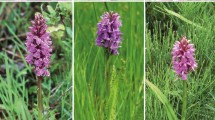Abstract
Selaginella moratii W. Hagemann & W. Rauh, spec. nova, is described. The Madagascarian plant from Fianarantsoa has a strongly differentiated subterranean rhizome system with a dichocladial mother rhizome bearing anisotomous branch systems with tufted tubers. These rhizophore tubers are observed for the first time inSelaginella. The green photophilous aerial shoots are produced by unbranched subterranean runners. The plant is adapted to carpets ofColeochloa setifera lying on granite rocks. Within these carpets,Selaginella moratii is associated withDrosera, Genlisea, Xerophyta, Myriothamnus, Kalanchoë, Senecio, andAloë among others. The description of the unique plants ofSelaginella moratii Rauh & Hagemann is based on alcohol-fixed material collected in 1963 by the senior author. The largest plants from this material measured approximately 10 cm. It is unknown whether larger plants exist in nature. It must be stated that the collected material is incomplete in many respects. Thus, it does not permit a complete reconstruction of the growth form of the natural plants, and further, it turned out that some anatomical details could not be sufficiently cleared up. Due to the fact that, in the natural sites, plant collectors can see only the aerial shoot systems, which show no striking differences to other dorsiventral selaginellas, it happened that the species was overlooked. Also, since the collected material has not been described until now, the plant has not been rediscovered since the year of its first observation. Thus, a comprehensive comparative study of the living plants remains a desideratum.
Similar content being viewed by others
References
Alston, A. H. G., 1932:Selaginellaceae. — InChristensen, A., (Ed.): ThePteridophyta of Madagascar. — Dansk Bot. Ark.7: 193–201, pl. 78–80.
Goebel, K. v., 1930: Organographie der Pflanzen Vol. 2, 2nd edn. — Jena: G. Fischer.
Hagemann, W., 1989: Acrogenous branching in pteridophytes. — InShing, K. H., Kramer, K. U., (Eds.): Proceedings of the International Symposium on Systematic Pteridology, pp. 245–258. — Beijing: China Science and Technology Press.
Hieronymus, G., (with collaboration ofSadebeck, R.) 1902:Selaginellaceae. — InEngler, A., Prantl, K., (Eds.): Die natürlichen Pflanzenfamilien. I. Teil, Abt. 4, pp. 621–715. — Leipzig: Engelmann.
Koechlin, J., Guillaumet, J. L., Morat, P., 1974: Flore et végétation de Madagascar. Flora et Vegetatio Mundi5. — Vaduz: Cramer.
Siegert, A., 1964: Morphologische, entwicklungsgeschichtliche und systematische Studien anPsilotum triquetrum SW. I. Allgemeiner Teil: Erstarkung und primäres Dikkenwachstum der Sprosse. — Beitr. Biol. Pflanzen40: 121–157.
Troll, W., 1939: Vergleichende Morphologie der höheren Pflanzen. 1. 2. Teil. — Berlin: Borntraeger.
—, (with collaboration ofHöhn, K.) 1973: Allgemeine Botanik. 4th edn. — Stuttgart: Enke.
Tryon, R., Tryon, A. F., 1982: Ferns and allied plants with special reference to tropical America. — New York, Heidelberg, Berlin: Springer.
Webster, T. R., Steeves, T. A., 1964: Observations on drought resistance inSelaginella densa Rydb. — Amer. Fern J.54: 189–196.
Author information
Authors and Affiliations
Rights and permissions
About this article
Cite this article
Rauh, W., Hagemann, W. Selaginella moratii, spec. nova (Selaginellales), a remarkable new species from Central Madagascar. Pl Syst Evol 176, 205–219 (1991). https://doi.org/10.1007/BF00937907
Received:
Revised:
Accepted:
Issue Date:
DOI: https://doi.org/10.1007/BF00937907




